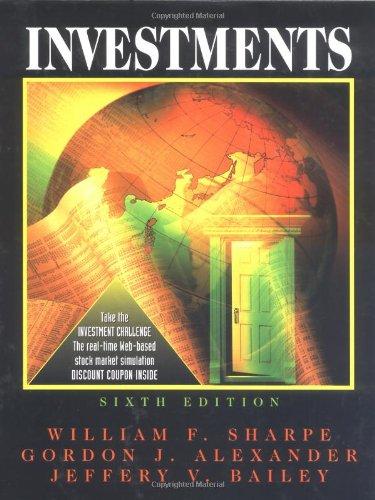Answered step by step
Verified Expert Solution
Question
1 Approved Answer
The company recently reorganized its debt structure at no extra expense, consolidating all liabilities into a single bond maturing in precisely 5 years. This strategic
The company recently reorganized its debt structure at no extra expense, consolidating all liabilities into a single bond maturing in precisely years. This strategic move involved issuing new debt in an amount sufficient to retire all existing current liabilities and the longterm debt. Consequently, your Balance Sheet now solely consists of Owners Equity and Long Term Debt. Present estimates suggest that the Market Value of the firm's assets stands at $ million, with an approximate standard deviation of
What are the Market Value numbers for the Equity and Debt?
Following the debt restructuring, one of the company's major shareholders has requested a meeting with you and the CEO to explore several opportunities she believes could benefit all company stakeholders. The investor seeks your assistance regarding two mutually exclusive investments, each requiring $ million in financing, exclusively funded by a bond with terms similar to the existing longterm debt. The estimated cost of issuing this bond is of the notional value, and we expect the bond to precisely cover the $ million requirement. Both investments are projected to generate cash flows with present values of $ million.
The first investment proposal aims to consolidate operations, thereby reducing the company's overall risk. As a result, the newly estimated standard deviation of assets is approximately What would be the revised Market Values of Equity and Debt following this investment?
The second investment opportunity involves introducing a new product, significantly increasing the company's risk profile. With this, the newly estimated standard deviation of assets rises to What would be the updated Market Values of Equity and Debt considering this investment?
Provide an analysis of the findings from b and c Specifically, consider whether engaging in either of the investments would result in benefits for all stakeholders involved.
Given:
Income Statement
Sales $ Taxes:
COGS $
Other expenses $ Shares Outstanding
Depreciation $ MarkettoBook Ratio
EBIT $ Depreciation of New Assets
Interest $ Dividend growth in the last years
Taxable income $
Taxes $
Net income $
Dividends $
Add to RE $
Balance Sheet
Assets Liabilities & Owners Equity
Current Assets Current Liabilities
Cash $ Accounts Payable $
Accounts Receivable $ Notes Payable $
Inventory $ Total CL $
Total CA $ Long Term Debt $
Fixed Assets Owners Equity
Net PP&E $ Common Stock $
Retained Earnings $
Total Equity $
Total Assets $ Total L & OE $
Step by Step Solution
There are 3 Steps involved in it
Step: 1

Get Instant Access to Expert-Tailored Solutions
See step-by-step solutions with expert insights and AI powered tools for academic success
Step: 2

Step: 3

Ace Your Homework with AI
Get the answers you need in no time with our AI-driven, step-by-step assistance
Get Started


